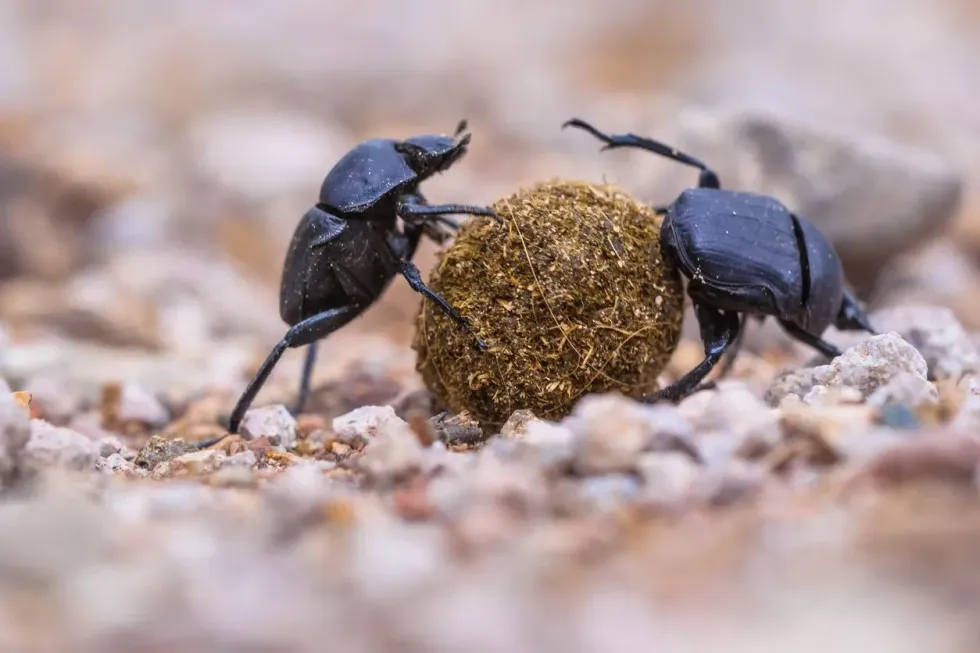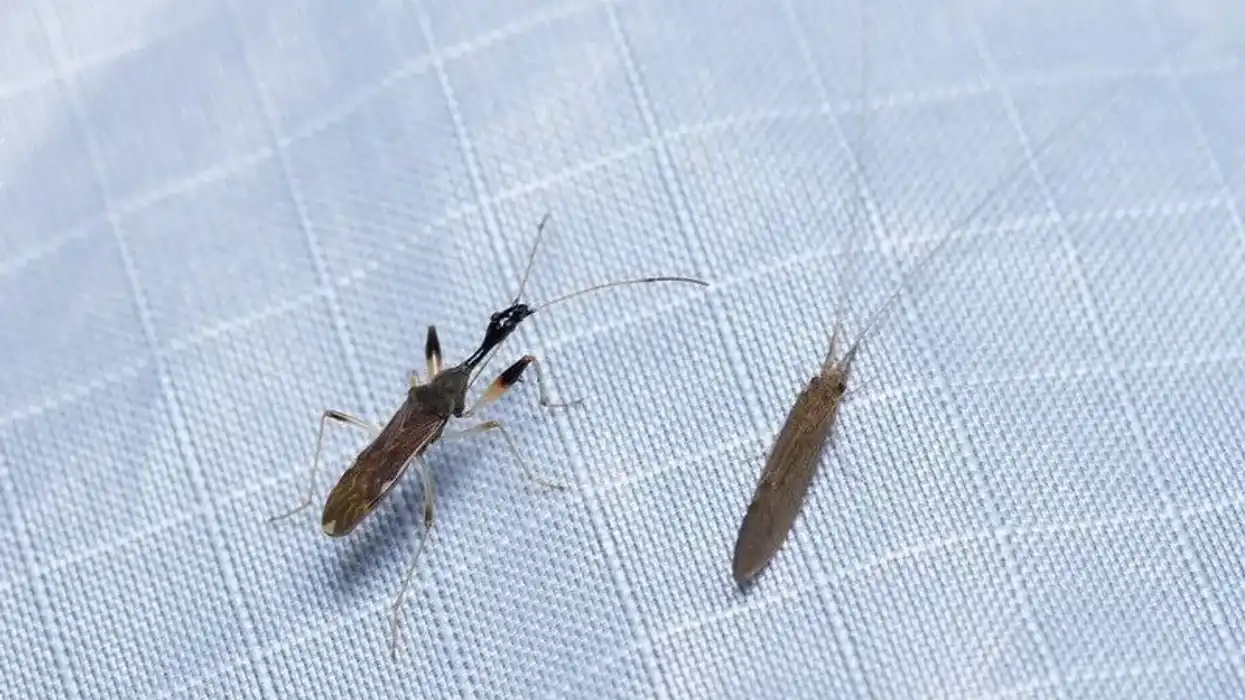Dung beetles are a type of beetles that mainly feed on the feces of mammals.
They are also known as rollers as they roll dung into circular balls. They use this as food or as chambers for breeding.
Dung beetles search for dung using their powerful sense of smell. They live in most habitats except Antarctica.
They are greatly influenced by environmental factors. They usually do not drink or eat anything else as dung provides all the necessary nutrients for their survival. However, some dung beetles feed on mushrooms, decaying fruits, and leaves.
Dung beetles play a very important part in farming and tropical forests as they improve soil fertility and help in recycling by burying and consuming dung. They also help in seed dispersal present in animal feces.
A special species of dung beetle can navigate using the patterns of the moonlight. Interestingly, they are the first animal known to do so. Dung beetles are classified into three types based on their functions such as – Rollers, Tunnelers, and Dwellers. The rollers roll the dung into balls and bury them for food or for a brooding ball.
If you like these true facts about the dung beetle, then you'll surely like these facts about the water beetle and the mud dauber wasp too!
Dung Beetle Interesting Facts
What type of animal is a dung beetle?
A Dung beetle is a type of insect belonging to the beetle species. Most beetles of this species have dull to shiny black wings that may have ridges. Dung beetles use their wings to fly several miles in search of the perfect dung pat.
Dung beetles are divided into three categories, tunnellers that bury dung wherever they find it, dwellers that simply live in the dung, and rollers that make a ball of dung and roll it away to bury elsewhere.
What class of animal does a dung beetle belong to?
Dung beetles belong to the Insecta class.
How many dung beetles are there in the world?
An exact number of the dung beetle population is impossible to state as there are over 30,000 dung beetle species.
Where does a dung beetle live?
Dung beetles can be found in deserts, grasslands, wetlands, and savannas on all continents, excluding Antarctica.
Dung beetles are called dung beetles because, as larvae and adults, they eat and live in and around animal droppings.
What is a dung beetle's habitat?
Dung beetles are species-specific feeders and also live in specific habitats. Most species can be seen exclusively in forests or pasture ecosystems. Dung beetles serve as an indicator for monitoring and understanding of impacts of the human-influenced changes in habitats like forests.
Who do dung beetles live with?
Dung beetles are mostly solitary creatures that meet other beetles during the mating season only.
How long does a dung beetle live?
The little insects have a lifespan of approximately three years long.
How do they reproduce?
Most of the dung beetle species reproduce during the warmer months of spring, summer, and autumn. They meet and mate around dung. They make balls of dung from a pile of dung that is way bigger than their body weight for eating and reproducing.
During the mating process, the male offers the female a giant dung ball; if she accepts it, they roll it away together, or the females ride on it. In some instances, other dung beetles might try to steal the dung ball!
The pair then finds a good spot to bury the dung balls before mating. After the male has left, the females make one or two more dung balls and lay their eggs in each dung ball.
She then covers it with a mixture of saliva, her own feces and seals the dung balls underground. In some cases, mothers stay with the eggs, cleaning the hatched larvae and removing their feces.
What is their conservation status?
The IUCN Red List categorizes dung beetles under the Least Concern.
Dung Beetle Fun Facts
What do dung beetles look like?

Dung beetles are round, with short wings that expose the abdomen's end. They are stocky, drab, well-armored in some instances, and have legs that are adapted for gripping, pushing, and digging.
They are usually dark in color, with a metallic luster. In many species of dung beetles, the males have a long, curved horn on top of its head. This horn comes in handy while fighting other males.
They use their antenna to detect the smell of excrement.
How cute are they?
Well, look or behavior-wise, they might not be the cutest insect that you might have laid your eyes upon. But the way how dung beetles use their hind legs to roll a ball of dung three or four times bigger than their own size is simply a cute thing to look at!
How do they communicate?
Like most beetles, dung beetles communicate with each other with chemicals. Males use the female's scent to locate them.
They have limited eyesight which makes them depend on smells and sounds in some cases. They usually scrape their mouthparts together or rub their legs on their bodies to make sounds. Dung beetles that live in deadwood drums make vibrations as a way to communicate with others.
How big is a dung beetle?
Dung beetles are small insects that vary in size depending on the species and regions they can be found in. They can grow from anywhere in between 5-30 mm.
How fast can dung beetles move?
Dung beetles can fly at a maximum speed of 18.64 miles per hour (30 km/h)!
How much does a dung beetle weigh?
Dung beetles can weigh up to 0.21 lb (99.22 g).
What are their male and female names of the species?
No particular name has been assigned for the male and female dung beetles.
What would you call a baby dung beetle?
After baby dung beetles hatch from their eggs, they are in the form of larvae, which is the word used to describe them.
What do they eat?
Dung beetles, as the name suggests, have a life revolving around dung. They feed on dung as most dung is nutrient-rich, especially from the feces or dungs of bigger animals. In some case, dung beetle species will hitch a ride on the dung supplier, and when fresh dung falls, they eat or roll it away.
Are they harmful?
Dung beetles are critical to nature. They may be gross due to their dung-dwelling habits, but they are not harmful to humans.
Would they make a good pet?
They are more of a method of pest control instead of pets. A dung beetle starter colony of 150o beetles can cost you around $400.
Did you know...
Dung beetles belong to the coprophagous category of insects, which means their diet is made up of feces of other organisms. Most of them pick to feed on the droppings of herbivore animals rather than the droppings of carnivores.
Contrary to popular belief, not all dung beetles are adept at rolling a ball of dung! There are earth-boring dung beetles (family Geotrupidae) that dig a tunnel right under the dung they find. Aphidian dung beetles from the subfamily Aphodiinae make the dung pile they find their home, which is commonly found in cattle farms.
Dung beetles roll or carry away dung from a pile of dung primarily as food for their young; their nests are equipped with poop, so when the eggs hatch, the larvae have a good amount of food helping them to grow safely in the nest.
Scientists have observed dung beetles acting curiously on their dung balls, suspecting them to navigate their surroundings. Scarabaeus satyrus, one species of the African dung beetle, navigates its way around using the milky way.
In some cases, dung beetles use the dung ball to cool off by getting on top of them when they are tired and want to keep their feet safe from the heat.
Dung beetles are exceptionally strong! These dung dwellers push a dung ball 50 times its weight! The record for the strongest dung beetle is a male Onthphaus taurus that pulled a heavy load that was 1,141 times its own weight.
Dung beetles and poop
Dung beetles not only are dwellers of feces (yes, including human poop! ); they eat feces and mainly pick through and find the tiniest bits as these bits have nitrogen in them.
They get their quota of protein from the nitrogen and develop muscles that are immense to them. They also use dung balls to impress females into mating with them! Dung beetles fill their nests with dung balls which in turn helps the larvae to eat their way out around the interior of the ball.
Why is the Dung Beetle important?
Dung beetles help the ecosystem in many ways; they help in the recycling of nutrients in the soil when they bury dung. By removing the dung, they prevent parasitic flies from breeding in the fresh feces of animals.
Dung beetles also help in the spreading of seeds by feeding on the dung of fruit-eating animals, so they help in spreading the seeds by taking them far away, helping in the regeneration of forests.
They can help in building soil and changing soil particle textures, increasing porosity, and distributing microorganisms. They can be introduced in farms and pastures and act as natural pest control in everyday life. They can feed on a dung pile of cattle and break down the dung before parasites breed on the cattle dung and spread any disease.
Here at Kidadl, we have carefully created lots of interesting family-friendly animal facts for everyone to discover! Learn more about some other arthropods including the click beetle, or the atlas beetle.
You can even occupy yourself at home by drawing one on our dung beetle coloring pages.









